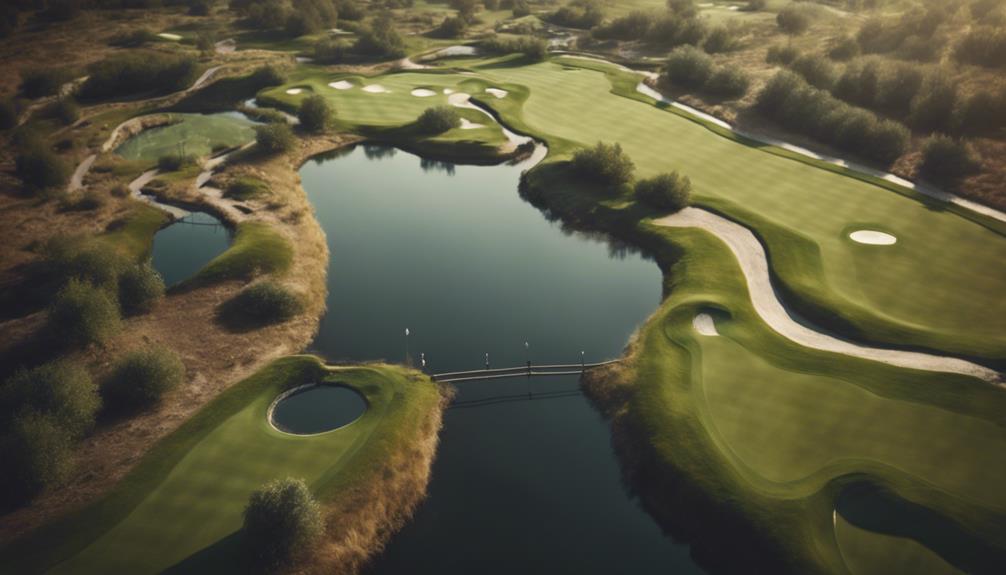- 7 Top Flite Golf Clubs XL for Improved Performance - September 28, 2024
- Top Flite Golf Clubs: Top 5 Reasons to Choose Them - September 28, 2024
- Top 3 Golf Club Fitters for a Perfect Swing - September 28, 2024
As you step onto a golf course, you're likely surrounded by lush, green landscapes that require significant amounts of water to maintain, but the reality is that many golf courses have made significant strides in reducing their water footprint in recent years. By selecting suitable turfgrass species, implementing efficient irrigation systems, and utilizing recycled water, golf courses have reduced water usage by 29% from 2005 to 2020. You'll find that many courses now prioritize water conservation, adopting precision irrigation techniques and alternative water sources. There's more to explore on the intricacies of golf course water efficiency – and the impact it has on the environment.
Key Takeaways
- Golf courses have made significant strides in water efficiency, reducing water usage by 29% from 2005 to 2020 in the U.S.
- Recycled water accounts for 21% of total water applied, and drought-resistant turfgrass minimizes water requirements.
- Precision irrigation techniques, such as hand watering and computerized control systems, optimize water application and reduce waste.
- Rain sensors, soil moisture monitoring, and weather stations help optimize water application, reducing waste and ensuring effective water use.
- Alternative water sources, like storage ponds and desalination plants, are being utilized to further minimize golf courses' environmental impact.
Turfgrass Selection and Management
By selecting turfgrass species suited to the local climate, golf course managers can reduce water consumption and enhance overall water efficiency. This knowledgeable turfgrass selection can significantly impact your water usage, as it guarantees the turfgrass is well-matched to thrive in the local conditions, needing less water to survive.
Additionally, integrating efficient irrigation systems can further optimize water application, reducing waste and runoff. To take it a step further, using moisture meters and sensors can assist in precise water application, guaranteeing the turfgrass receives precisely what it needs.
By combining these strategies, you can create a highly effective water management system. By making informed decisions about turfgrass selection and management, you'll be well on your way to minimizing water waste and maximizing water efficiency on your golf course.
With the appropriate tools and knowledge, you can develop a sustainable and eco-friendly golf course that not only conserves water but also reduces maintenance costs.
Water Conservation Strategies
As golf courses continue to optimize their water management systems, implementing targeted water conservation strategies becomes vital to minimizing waste and maximizing efficiency.
You'll be pleased to know that the industry has made significant progress in reducing water usage. Between 2005 and 2020, U.S. golf courses decreased their water usage by 29%, a notable achievement. In 2020, a total of 1.68 million acre-feet of water was applied on golf courses, with recycled water accounting for 21% of the total.
To achieve efficient water use, golf courses are adopting Best Management Practices (BMPs) that prioritize water conservation. One key strategy is selecting drought-resistant turfgrass, which requires less water to thrive.
Optimizing irrigation practices is another essential step in reducing water usage. By implementing these strategies, golf courses can minimize waste and guarantee that every drop of water is used efficiently.
As you explore ways to reduce water usage, keep in mind that a combination of these approaches can lead to significant water savings, ultimately contributing to a more sustainable future for the industry.
Precision Irrigation Techniques

You can enhance water application on your golf course by leveraging precision irrigation techniques. These methods have been instrumental in reducing water usage by 29% in U.S. golf facilities from 2005 to 2020. By implementing unique irrigation management approaches, you can achieve significant water savings in your golf course maintenance.
One key strategy is to utilize hand watering practices efficiently, which has been shown to improve water efficiency on golf courses. Additionally, advanced technologies such as computerized control systems can enable efficient water application, ensuring that every drop counts.
By applying precision turf management principles, you can further enhance water conservation efforts in your golf course maintenance. With precision irrigation techniques, you can target specific areas of your course that require more water, reducing waste and minimizing overwatering.
General Water Efficiency Measures
In conjunction with precision irrigation techniques, incorporating general water efficiency measures can further optimize water application on your golf course, leading to even greater water savings and environmental sustainability. By adopting best management practices, you can reduce water use and ensure effective water application.
The data shows that golf courses in the U.S. have made significant progress in water conservation, with a 29% reduction in water usage from 2005 to 2020. This is equivalent to approximately 744,000 acre-feet of water saved. Additionally, the median acre-feet per acre has improved by 23% since 2005, indicating a more efficient use of water resources.
To build on this success, it's crucial to continue implementing general water efficiency measures, such as rain sensors, soil moisture monitoring, and weather stations. These technologies help you make informed decisions about water application, reducing waste and ensuring that water is applied only when necessary.
Alternative Water Sources Design

By exploring alternative water sources, golf courses can further decrease their environmental footprint and reliance on potable water supplies, building on the water efficiency gains achieved through precision irrigation and general water efficiency measures.
You can utilize alternative water sources like storage ponds, tertiary treated effluent, brackish water, and desalination plants for irrigation. On-site reverse osmosis desalination plants, for instance, are constructed to desalinate water for salt-tolerant grasses on golf courses. This approach helps reduce the environmental impact and guarantees sustainable water management practices.
Modern golf course architects incorporate natural water features and native plant species to minimize water consumption and enhance sustainability. By incorporating alternative water sources and sustainable design elements, you can markedly contribute to water conservation efforts on golf courses.
This integrated approach enables golf courses to maintain their aesthetic appeal while reducing their ecological footprint. By adopting these measures, you can create a more sustainable and environmentally friendly golf course that aligns with the principles of water efficiency and conservation.
Frequently Asked Questions
Do Golf Courses Really Use That Much Water?
You're wondering if golf courses really use that much water, and the answer is yes, but efforts towards water conservation, like adopting alternative irrigation methods and drought-resistant landscaping, are making a significant environmental impact.
Does Golf Use a Lot of Water?
As you step onto the lush green, you might wonder, does golf use a lot of water? Yes, it does, but you're heartened to learn that golf course irrigation has become more sustainable, with water conservation practices reducing environmental impact.
How to Reduce Water Usage on Golf Courses?
To reduce water usage on golf courses, you can implement smart irrigation systems, switch to drought-resistant grasses, and utilize water recycling, which accounted for 21% of water applied in 2020, resulting in significant water conservation.
Do Lawns and Golf Courses Conserve Water?
You might be surprised to know that recycled water accounts for 21% of water applied in golf courses, demonstrating a commitment to lawn care sustainability.
Conclusion
As you weigh the environmental impact of golf courses, remember that every drop counts. By adopting efficient turfgrass selection and management, water conservation strategies, precision irrigation techniques, and alternative water sources, courses can greatly reduce their water footprint.
After all, 'an ounce of prevention is worth a pound of cure.' By taking proactive measures, golf courses can guarantee a sustainable future for the game we love, while also safeguarding our planet's most precious resource.




